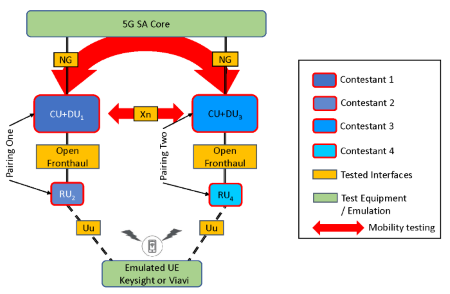At the National Telecommunications and Information Administration we are working to foster the development of an open 5G wireless ecosystem to help the private sector bring new life and innovation to a marketplace held back by few vendors and little competition.
One way we’re doing this is through our 5G lab at the Institute for Telecommunication Sciences, where we partnered with the Department of Defense for our 2023 5G Challenge. The 2023 5G Challenge tested whether an open 5G ecosystem can work in real world scenarios.
Challenge Structure Recap
These results are now available in the 2023 5G Challenge Closing Ceremony video
The 2023 5G Challenge tested whether components of an Open Radio Access Network (Open RAN), such as antennas and radio base stations, can work together to ultimately create a multi-vendor subsystem end-to-end (E2E) 5G network.
The Challenge separated the RAN into two contestant parts: a radio unit (RU) subsystem—the first point of contact between user devices and the network, and a central unit and distributed unit pair (CU+DU) subsystem—these units work together to handle specific functions from the RU subsystem. The Challenge also set a brisk pace for contestants to form 5G networks with subsystems from two, three, or four different vendors.
During Stage One, the 5G Challenge organizers chose contestants based upon white paper applications. During Stage Two, the host lab evaluated each contestant’s subsystem individually, with wrap-around emulators. During Stage Three, a CU+DU contestant and RU contestant worked together to establish an Open RAN with E2E network connectivity. In Stage Four, two contestant pairs from Stage Three worked together to demonstrate mobility. “Mobility” refers to inter-RAN handover events that occur as a phone switches from one base station to another.
After our Stage Three recap was published, a fourth pairing passed Stage Three:
 Stages Three and Four Testing Results
Stages Three and Four Testing Results
- JMA Wireless CU+DU and QCT/Benetel RU
Their success allowed two teams to move to Stage Four mobility testing:
- Mavenir Systems CU+DU and NewEdge RU, with Radisys CU+DU and LIONS Technology RU
- Capgemini CU+DU and QCT/Benetel RU, with JMA Wireless CU+DU and QCT/Benetel RU
These competing teams achieved mobility over both the NG (5G core based) and Xn (gNB to gNB direct) interfaces. In a photo finish, both teams passed all mandatory and conditional mandatory tests in the 2023 5G Challenge Test Plans, and a tie breaker decided the winner: Mavenir Systems CU+DU and NewEdge RU, with Radisys CU+DU and LIONS Technology RU. According to the 2023 5G Challenge Mobility contestants, this is the first time that multi-vendor handover has been achieved with an Open RAN system.
The judges awarded the Multi-vendor E2E Integration Testing first prize to Capgemini CU+DU and QCT/Benetel RU, which passed 100 percent of the Stage Three tests. Second prize went to Radisys CU+DU and LIONS Technology RU, which passed 94 percent of the Stage Three tests. As with mobility testing, this was a very close competition, with JMA Wireless CU+DU and QCT/Benetel RU passing 91 percent of the Stage Three tests.
Best in Show Prizes
Fujitsu Network Communications, Inc. in partnership with AT&T and JMA Wireless won the two “Best SBOM” prizes, for the outstanding quality of their Software Bills of Materials (SBOM) and Vulnerability Exploitability eXchanges (VEX). An SBOM is a formal, machine-readable inventory of software components and dependencies. A VEX provides information on specific vulnerabilities (e.g., the vulnerability was fixed). The SBOM and VEX work together to expedite such 5G network operator tasks as security risk assessment, supply chain management, and vulnerability remediation.
LIONS Technology won the award for “Best Collaborator,” based on collaboration ratings submitted by its partner contestants and host lab CableLabs/Kyrio.
Annie George, Kyrio’s Director of Wireless Engineering, said, “Both senior leadership and engineering staff from LIONS team were intimately involved in testing stages including providing dedicated onsite individuals, timely overnight support from their remote teams, and adjusting schedules accordingly to meet the testing deadlines.”
2022 Lessons Applied to the 2023 Challenge
Flexibility is a necessity for open RAN technology but caused difficulties for the 2022 5G Challenge contestants. While their subsystems complied with different sets of standards and specifications, contestant subsystems did not have a standard set of optional features, which caused inconsistencies. As a result, in 2023 the host lab facilitated pre-integration coordination. Overall, this enabled multi-vendor integration and resulted in an increase in successful E2E multi-vendor integrations from one in 2022 to four in 2023.
The 5G Challenge has identified a need for a clear baseline for industry open RAN integration specifications and lab venues for vetting these specifications. Congratulations again to the winners who have set a new benchmark for industry collaboration to bring innovation and competition to the mobile equip

